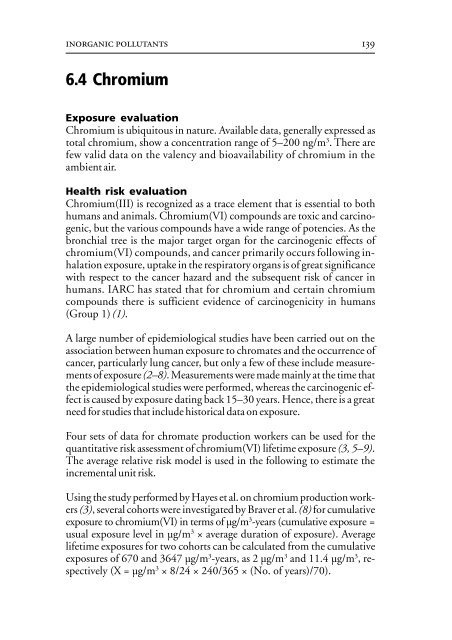Air Quality Guidelines - World Health Organization Regional Office ...
Air Quality Guidelines - World Health Organization Regional Office ...
Air Quality Guidelines - World Health Organization Regional Office ...
Create successful ePaper yourself
Turn your PDF publications into a flip-book with our unique Google optimized e-Paper software.
inorganic pollutants<br />
6.4 Chromium<br />
139<br />
Exposure evaluation<br />
Chromium is ubiquitous in nature. Available data, generally expressed as<br />
total chromium, show a concentration range of 5–200 ng/m 3 . There are<br />
few valid data on the valency and bioavailability of chromium in the<br />
ambient air.<br />
<strong>Health</strong> risk evaluation<br />
Chromium(III) is recognized as a trace element that is essential to both<br />
humans and animals. Chromium(VI) compounds are toxic and carcinogenic,<br />
but the various compounds have a wide range of potencies. As the<br />
bronchial tree is the major target organ for the carcinogenic effects of<br />
chromium(VI) compounds, and cancer primarily occurs following inhalation<br />
exposure, uptake in the respiratory organs is of great significance<br />
with respect to the cancer hazard and the subsequent risk of cancer in<br />
humans. IARC has stated that for chromium and certain chromium<br />
compounds there is sufficient evidence of carcinogenicity in humans<br />
(Group 1) (1).<br />
A large number of epidemiological studies have been carried out on the<br />
association between human exposure to chromates and the occurrence of<br />
cancer, particularly lung cancer, but only a few of these include measurements<br />
of exposure (2–8). Measurements were made mainly at the time that<br />
the epidemiological studies were performed, whereas the carcinogenic effect<br />
is caused by exposure dating back 15–30 years. Hence, there is a great<br />
need for studies that include historical data on exposure.<br />
Four sets of data for chromate production workers can be used for the<br />
quantitative risk assessment of chromium(VI) lifetime exposure (3, 5–9).<br />
The average relative risk model is used in the following to estimate the<br />
incremental unit risk.<br />
Using the study performed by Hayes et al. on chromium production workers<br />
(3), several cohorts were investigated by Braver et al. (8) for cumulative<br />
exposure to chromium(VI) in terms of µg/m 3 -years (cumulative exposure =<br />
usual exposure level in µg/m 3 × average duration of exposure). Average<br />
lifetime exposures for two cohorts can be calculated from the cumulative<br />
exposures of 670 and 3647 µg/m 3 -years, as 2 µg/m 3 and 11.4 µg/m 3 , respectively<br />
(X = µg/m 3 × 8/24 × 240/365 × (No. of years)/70).

















